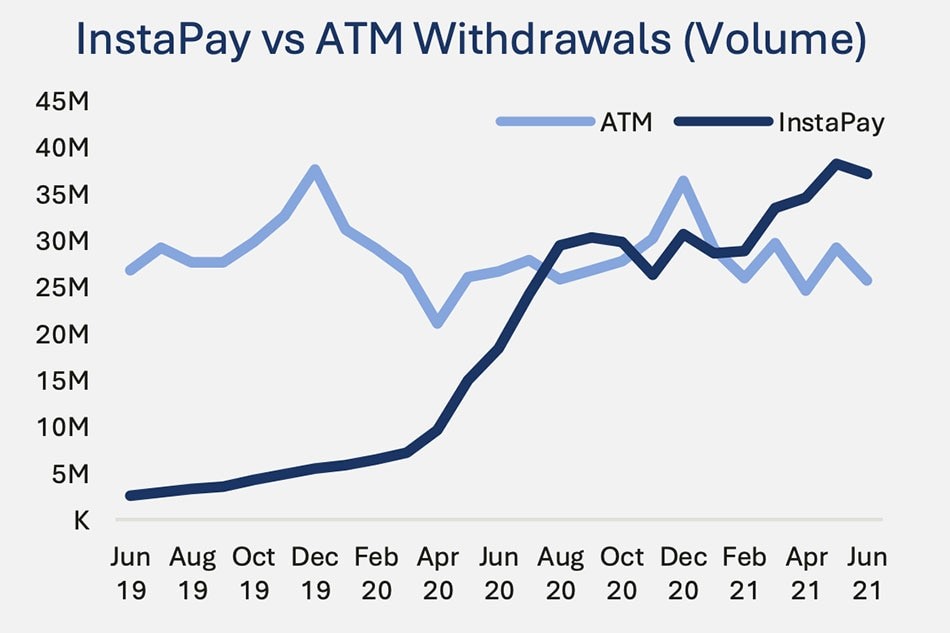ABS-CBN News Posted at Dec 28 2021 10:26 AM
MANILA - The Bangko Sentral ng Pilipinas (BSP) said on Tuesday it is confident it can achieve its digitalization goals ahead of 2023.
Under its Digital Payments Transformation Roadmap (DPTR), the BSP aims to digitize at least 50 percent of retail payments volume and encourage 70 percent of Filipino adults to open bank accounts by 2023.
“We are confident of hitting the twin goals...With financial digitalization, I am confident that we will achieve the stronger post-COVID economy that we envision sooner rather than later,” said BSP Governor Benjamin E. Diokno said during the recently concluded HSBC Digital Bankers Forum.
“As more Filipinos embrace the convenience of digital payments, we expect the phenomenal growth in digital financial transactions to continue in the years ahead,” he added.
Share of digital payments to the total financial transactions reached 20.1 percent in 2020 from 14 percent in 2019, the central bank said.
Registered e-money accounts hit 138.8 million in 2020 with the total number of transactions at 1.7 billion, data show.
The number of basic deposit accounts reached 7 million with P4.8 billion deposits in the first quarter of 2021, which brought the total number of banked Filipino adults to 53 percent in the period, the BSP said.
As of October this year, at least 1 in 5 payments was already digital, a BSP report said.
Both InstaPay and PESONet transactions, or the electronic money transfers under the BSP's National Retail Payment System, have surged in both volumes and values during the COVID-19 pandemic.
BSP says 1 in 5 payments now digital; InstaPay overtakes ATM withdrawals in 2020
 Digital payment done through QR code. Screengrab from BSP report
Digital payment done through QR code. Screengrab from BSP report
One in 5 payments in the Philippines is now done digitally as the country moves towards its digitalization goals, Bangko Sentral ng Pilipinas Gov. Benjamin Diokno said Monday.
Under its digitalization roadmap, the BSP aims to digitalize at least 50 percent of payments and onboard 70 percent of the population to the financial system by 2023.
The volume of digital payments has "grown substantially" to 20.1 percent of total average monthly payments from 14 percent in 2019 overshooting estimates of 20 percent, Diokno said in a report released by the BSP Monday.
The growth is fueled by high-frequency, low-value retail transactions and person-to-person payments, according to the "Status of Digital Payments in the Philippines 2021 Edition" report.
"We achieved a few milestones in our digital transformation journey. We hit our “20 percent by 2020” target, with one in five payments now digital. The BSP supports the development of innovative financial services to realize our inclusive growth agenda," the central bank chief said.
The combined PESONet and InstaPay transfers in volume grew by 484.7 percent in 2020 as well as 165.4 percent in terms of value, the central bank said.
InstaPay transfers have also "overtaken" ATM withdrawals, while PESONet is "on track" in minimizing the gaps and may exceed check volume over time, it said.
 InstaPay vs. ATM Withdrawal. Chart: BSP
InstaPay vs. ATM Withdrawal. Chart: BSP
With this development, the BSP is "optimistic" in achieving this goal by 2023, he said.
Digital payments have emerged as "vital and inevitable solutions" to enable Filipinos to complete transactions without physical contact, therefore, reducing health risks, the BSP study report said.
COVID-19 has emerged as a "catalyst" for the growth of digital payments, it added.
Diokno said the BSP laid out regulatory reforms meant to support a cash-lite economy.
The BSP earlier approved a framework recognizing digital banks and had given out 6 digital banking licenses.
Digital banks are financial technology companies with no physical branches and are designed to make onboarding into the financial system easier and more accessible especially for the unbanked.